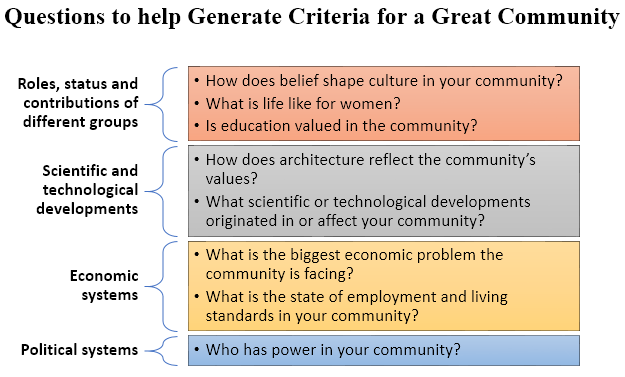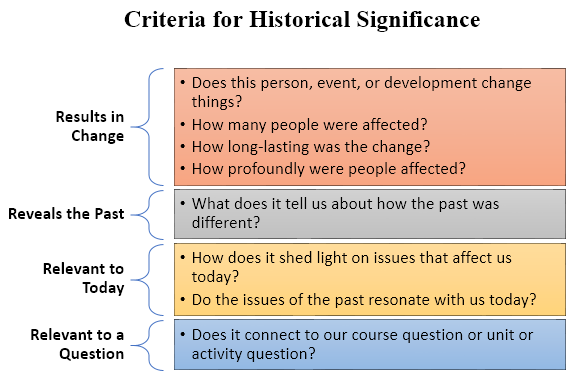CHY4U
World History Since the Fifteenth Century
Unit 1: 1450 - 1650: What Were They Thinking?
Activity 2: Cities of the World
In this activity, you will learn what eight cities around the world were like in 1450. Each city will be presented to you in an infographic; this approach will provide not only visual representations, but also some inspiration for a map-based assessment task you will complete later in the unit. You will also read primary sources to determine different perspectives to create a resolution for change.
Each infographic attempts to answer three or four questions that will help you understand the city and its culture. Below is a list of similar questions that we can use to evaluate the state of modern communities.
 What Makes a Great Community?
What Makes a Great Community?
To prepare for this activity, describe 3 features of a great community (eg. equality for all groups, employment, etc.) and assess whether your own present-day community is in fact great according to your own definition.
Using Criteria
Throughout this course you will be generating and using criteria. In this activity, you will generate the criteria for a great community, then you will be better able to assemble the evidence and draw your conclusions. We can use criteria to help us make everyday decisions, such as;
- Which school should I attend?
- What should I study?
In historical investigations, using criteria gives rigour to our arguments and helps us to understand and use the evidence.
A set of standards or definitions against which you will assemble evidence and draw conclusions.
The quality of being extremely thorough, accurate, careful and meticulous.

The following infographics will introduce you to eight cities in 1450: Beijing, Kyoto, Seoul, Timbuktu, Constantinople, Venice, Seville, and Tenochtitlan. When you reach the infographic about Constantinople, you will be asked to decide which of two primary sources should be added to the infographic.
Which Source Best Explains the Importance of Constantinople?
Once you have examined the infographic, you will become a historian and make a decision about historical significance. Below are two primary sources about the fall of Constantinople. The first is from an Order of Knights petitioning Christian leaders to attack Mehmed and his forces. The second is from a short account of the response of the people of Crete, an island in the Mediterranean, to the news of Constantinople’s fall. While Crete had once been controlled by Constantinople, it was ruled by Venice in the 15th century.
 Which Source?
Which Source?
Explain which primary source you believe should be included in this infographic. Your choice should answer the question: which primary source best explains the importance of Constantinople?
Excerpt from Letter of the Knights of St. John on Rhodes which was sent to Jerusalem to the Margrave of Brandenburg.
Original Source information: from Trans. by W.L. North from the edition of A. Pertusi, Testi inediti e poco noti sulla caduta di Costantinopoli, ed. A. Carile. Il Mondo medievale: sezione di storia bizantina e slava 4. Bologna: Pàtron Editore 1983, #9, pp. 54-56.
It is believed that he [Mehmed] is preparing a new fleet from scratch, since he intends to make all the islands of the Aegean archipelago subject to him or to destroy them if he can. For his heart swells with pride and he boasts that he has equaled or surpassed the deeds of Alexander of Macedon. He also threatens that he will attempt to do what Alexander never did: push into Italy and the regions of the West with his arms and might and see whether fortune shall favor him there as it has throughout the East. This is why all Christian kings and princes should turn their minds to some sort of pact so that they may resist the ferocious power of this tyrant who has been roused to destroy Christians, unless God provides otherwise, and turn all their powers to the destruction of the Turk himself. For this would happen easily if they ever met together in peace and unity, came together, or agreed for the sake of the honor of the Catholic faith and protection of Christianity that the sect of Mohammed should no longer rage against the worshippers of Christ and at the same time entreated almighty God that His Grace make provision when human powers are not enough, that God who keeps you to your vow and happily leads your company to our city of Rhodes.
Annotation on Greek manuscript
British Museum Add. 34060 f.1v, trans. from the Greek by W. L. North from the edition in A. Pertusi in Testi inediti e poco noti sulla caduta di Costantinopoli, ed. A. Carile. Il Mondo medievale: sezione di storia bizantina e slava 4. Bologna: Pàtron Editore 1983, #22, p. 214.
In the year 1453, on June 29, a Friday, there came from Constantinople three Cretan caravels those of Sgouros, Hyalina, and Philomatos. They said that on the 29th of May, the third day of Saint Theodosia, at the third hour of the morning [9 am], the Hagarenes, that is the troops of Mehmet Celebi, entered the city of Constantinople. They also said that they killed the emperor, the Lord Constantine Dragas and Palaiologos. Then there was great sorrow and much weeping on Crete because of the sad news that had arrived. Indeed nothing worse than this has ever happened or ever will happen. May the Lord God be merciful to us and free us from His fearful threats.
In this activity you learned about:
- what eight important cities--Beijing, Constantinople, Kyoto, Seoul, Seville, Tenochtitlan, and Venice--were like in 1450;
- numerous primary source documents that are relevant to those cities.
 Which City was the Greatest?
Which City was the Greatest?
Use the criteria you generated earlier in the What Makes a Great Community? activit to think about why one of the cities in the infographics can be considered the greatest in 1450, and why another city should be considered less great.
You should refer to some of the categories discussed earlier:
- social roles and groups
- scientific and technological developments
- economic and political systems
 Which City is the most Historically Significant?
Which City is the most Historically Significant?
In a reflection, explain which city you think was the most historically significant in 1450-1500. Whether it was a great community is not exactly the same thing. Your response should:
- be supported by the sources and information in the infographics;
- reference the historical significance criteria.
